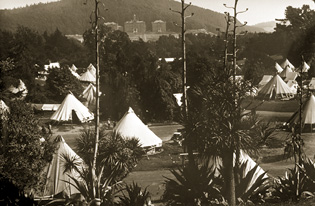The destructive power of San Francisco's 1906 earthquake and fire shocked the nation and the world.
Apart from the more than 3,000 casualties, huge portions of the city were obliterated or made uninhabitable. Many of the city's hospitals and medical facilities were also damaged or destroyed, and more than 225,000 of the city's 400,000 residents were left homeless.
Less than a decade earlier, the Affiliated Colleges - the precursor to today's UCSF - had relocated from various downtown locations to a site on Parnassus Heights below Mount Sutro. As the scope of the disaster became clear, a tent city of some 40,000 displaced San Franciscans took up residence in Golden Gate Park.
Disaster Relief
Doctors and medical students associated with the medical college sprang into action, helping the San Francisco Department of Public Health and the US Army set up areas to take care of the sick and wounded.
 |
| A tent city of some 40,000 displaced San Franciscans took up residence in Golden Gate Park. |
"The Army set up a field hospital in Golden Gate Park," says UCSF historian Nancy Rockafellar. "The Army was really responsible for first response, and they collaborated with physicians to care for injured and homeless refugees. Official reports from the Army show that there was fairly immediate cooperation between the Army and civilians. There really was a roll-up-your-sleeves response, with physicians, dentists and nurses working alongside the military. There was a real mix of people pitching in."
Less damaged than other hospitals in the city, Letterman General Hospital in the Presidio provided critical emergency care following the temblor, treating 200 people in the days after the quake.
Rockafellar says that the rapid medical responses to the 1906 earthquake and fire, as well as measures to prevent further disease outbreaks, were commendable. Realizing that a tainted water supply would cause an epidemic, such as typhoid fever and other waterborne illnesses, the Army initiated safe drinking water practices by boiling water, controlling latrines and keeping outdoor kitchens clean.
"They were understandably worried about typhoid fever," she says. "According to official records, there were 99 cases, but these patients were quickly diagnosed, treated and isolated, which was a real feat. There were also 123 cases of smallpox, and these patients were also quickly isolated and their contacts vaccinated. Overall, the Department of Public Health and the military did a good job maintaining sanitation in the large refugee camps."
Fires following the earthquake burned for three days and three nights. One of the areas hardest hit was Chinatown. Records show that city officials tried to permanently move the Chinese from Chinatown (a valuable piece of real estate) to Hunters Point, but the Chinese resisted, Rockafellar says.
"In the end, city officials did not want to lose the Oriental trade and the economic benefits. But it really is a testament to the tenacity of the Chinese themselves."
Disaster Spurs New Hospital
The outbreak of bubonic plague that followed the earthquake further taxed relief efforts, which were transferred three months later from military control to local officials and the Red Cross and Relief Corporation, according to the Golden Gate National Parks Conservancy.
Of the 160 cases of bubonic plague, 77 people died. City officials brought in officer-doctors from the US Public Health and Marine Hospital Service (later known as the US Public Health Service), who set up bacteriological labs to diagnose Yersinia pestis, instituted a bounty on rats, and forcefully led a citywide effort which stopped the advance of the plague, Rockafellar notes.
The earthquake and plague also changed what had been an academic discussion about creating a new teaching hospital on Parnassus Heights into an urgent civic priority. With faculty support and the approval of UC President Benjamin Wheeler, the first two years of the medical curriculum were moved to Berkeley. Space in the Medical College Building was remodeled in just 11 months. The first UC Hospital opened to patients in April 1907, just one year after the earthquake.
Money donated by a committee of city officials supported the remodeling project. The argument for the new hospital stated that "the deplorable condition of the City and County Hospital, overcrowded as it is, renders it almost imperative that there be some such well-administered institution as the contemplated University Hospital would become under the management of the well-known physicians who are interested in it."
Patient care has been a continuous feature of the Parnassus campus for the last 100 years. With a staff now numbering more than 6,000, the UCSF Medical Center and UCSF Children's Hospital record more than 640,000 patient visits annually.
Sources: Jeff Miller and Lisa Cisneros
Links:
Bancroft Library, 1906 Earthquake coverage
